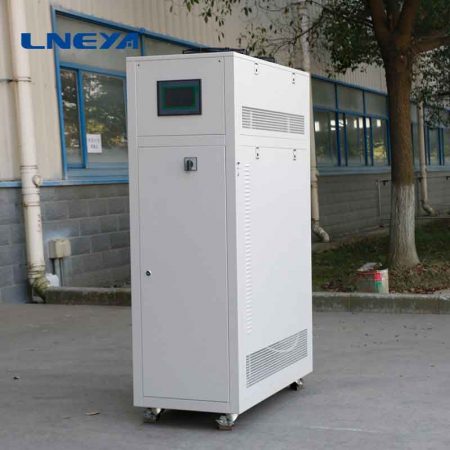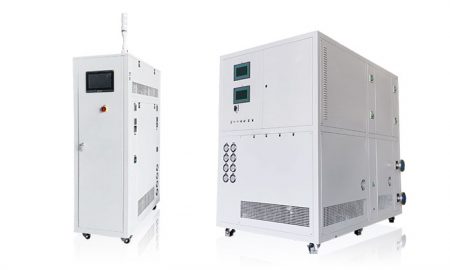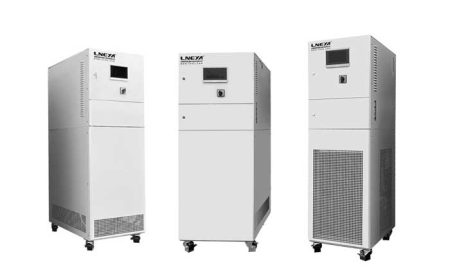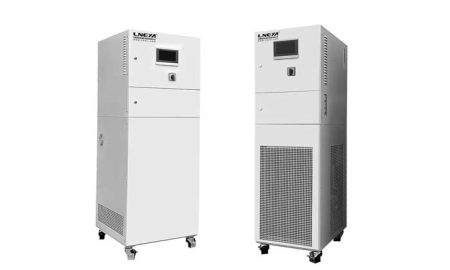Cold Water Recirculating System
Kontaktieren Sie uns noch heute für die perfekte Lösung zur Temperaturkontrolle
Overview of cold water recirculating system
The cold water recirculating system is configured for water cooling of production equipment. A cooling water system that uses water as the cooling medium and circulates it. After the cold water flows through the production equipment that needs to be cooled (often called heat exchange equipment, such as heat exchangers, condensers, and reactors), the temperature rises. If it is discharged immediately, the cold water is only used once (called a DC cooling water system). When the heated cold water flows through the cooling equipment, the water temperature will drop back, and the consumption of cold water will be greatly reduced, often saving more than 95%. Cooling water accounts for about 70% of industrial water consumption, so cold water recirculating system plays a role in saving a lot of industrial water.

Cold water recirculating system generally consists of the following parts:
1. Heat exchangers in the production process
2. Cooling the structure
3 circulating water pump and sump.
Cooling structures for cooling water cooling treatment generally use cooling pools or cooling towers. Its working process is as follows: the circulating water is transported by the water pump to the water supply main pipe, and then enters each production equipment that needs cooling treatment, flows through the parts that need to be cooled, and then collects into the return water main pipe, and sprays downwards through the water distribution pipe above the cooling water tower . When the fan on the top of the cooling water tower is running, the return water flows back into the water storage tank after sufficient heat exchange with the air flow in the packing layer.
Classification of cold water recirculating system
Cooling equipment can be divided into open type and closed type, so cold water recirculating system is also divided into open type and closed type. Open systems are more complex to design and operate.
Open type: There are two types of cooling equipment, cooling pools and cooling towers, both of which mainly rely on the evaporation of water to reduce the water temperature. Fans are often used in cooling towers to promote evaporation, and cooling water is often blown away. Therefore, the open cold water recirculating system must supply fresh water. Due to evaporation, the circulating water is concentrated, and the concentration process will promote salt scaling. Make-up water has a dilution effect, and its flow rate is often determined according to the concentration limit of circulating water. Usually the amount of added water exceeds the amount of water lost by evaporation and wind, so some circulating water (called sewage) must be discharged to maintain the balance of water.
In an open system, due to the contact between the water flow and the atmosphere, dust, microorganisms, etc. enter the circulating water; in addition, the escape of carbon dioxide and the leakage of materials in the heat exchange equipment also change the water quality of the circulating water. For this reason, circulating cooling water often requires treatment, including sediment control, corrosion control and microbial control. The determination of the treatment method is often related to the water quantity and quality of the make-up water, as well as the performance of the production equipment. When multiple agents are used, possible chemical reactions between agents should be avoided.
Closed The closed cold water recirculating system adopts closed cooling equipment, the circulating water flows in the tube, and the outside of the tube usually uses wind to dissipate heat. Except for the material leakage of the heat exchange equipment, there are no other factors that change the water quality of the circulating water. In order to prevent the formation of salt scale in the heat exchange equipment, sometimes the cooling water needs to be softened. In order to prevent heat exchange equipment from being corroded, corrosion inhibitors are often added; when using high-concentration and highly toxic corrosion inhibitors, pay attention to safety, and the cooling water discharged during maintenance should be properly disposed of.
E-Mail: info@lneya.com WeChat ID: +8615251628237 WhatsApp: +86 17851209193
 Präzisionskältemaschinen / Kleinkältemaschinen (Benutzerdefinierte Designs)
Präzisionskältemaschinen / Kleinkältemaschinen (Benutzerdefinierte Designs)
Die Kältemaschine kann in verschiedenen Industrien und Labors eingesetzt werden und unterstützt kundenspezifische Designs.
| Temperaturbereich | -18°C ~ +30°C | +5°C ~ +35°C Reihe |
| Kühlleistung | 0,35 ~ 0,9kW | 1,8 ~ 50kW |

Rückkühler (Benutzerdefinierte Designs)
Unser Rückkühler arbeitet mit Niedertemperatur-Kältetechnik, die Temperatur beträgt bis zu -120℃, und verschiedene Zubehörteile sind anpassbar.
| Temperaturbereich | Serie -25°C ~ +30°C | -45°C ~ +30°C Reihe | Serie -60°C ~ -20°C | Serie -80°C ~ -20°C | Serie -120°C ~ -70°C |
| Kühlleistung | 0,8 ~ 30kW | 0,75 ~ 12kW | 0,4 ~ 6kW | 0,2 ~ 6kW | 0,3 ~ 5kW |

Niedertemperatur-Kühlgeräte (Benutzerdefinierte Designs)
Wir haben uns auf die Herstellung von Niedertemperaturkältemaschinen mit einem Temperaturregelbereich von bis zu -150°C spezialisiert, die den Kühlbedarf verschiedener Branchen decken.
| Temperaturbereich | Serie -25°C ~ -5°C | Serie -45°C ~ -10°C | Serie -60°C ~ -10°C | Serie -80°C ~ -30°C | Serie -110°C ~ -50°C | Serie -150°C ~ -110°C |
| Kühlleistung | 12 ~ 360kW | 6 ~ 180kW | 6 ~ 180kW | 4 ~ 180kW | 2 ~ 120kW | 2,5 ~ 11kW |
 Chillers for Automotive Battery Test
Chillers for Automotive Battery Test
Temperatursimulation für die Qualitätsprüfung von Fahrzeugen: Prüfung der Batterielebensdauer, Prüfstand für Einspritzdüsen/Motoren, Airbag-Prüfung, Komponentenprüfstand, usw.
| Temperaturbereich | -25°C ~ +100°C | -40°C ~ +100°C | 0°C ~ +100°C | -40°C ~ +135°C |
| Kühlleistung | 2,8 ~ 38kW | 1,2 ~ 60kW | 1.8 ~ 60kW | 4 ~ 60kW |
Temperatur/Druck/Durchfluss können unabhängig voneinander geregelt werden.
1&2: eine Maschine für zwei Kontrollgruppen.
| Temperaturbereich | -40 ~ +100℃ 1&2 | 0 ~ +100℃ 1&2 |
| Kühlleistung | 1.8kW*2 ~ 60kW*2 | 1.8kW*2 ~ 60kW*2 |
Die Temperatur bleibt konstant, Druck und Durchfluss können unabhängig voneinander geregelt werden.
1&3: eine Maschine für drei Kontrollgruppen.
1&6: eine Maschine für sechs Kontrollgruppen.
| Temperaturbereich | -40 ~ +100℃ 1&2 | -40 ~ +100℃ 1&3 | -40 ~ +100℃ 1&6 | -20 ~ +100℃ 1&6 | 0 ~ +100℃ 1&2 | 0 ~ +100℃ 1&3 | 0 ~ +100℃ 1&6 |
| Kühlleistung | 2,5 ~ 60kW | 4 ~ 60kW | 10 ~ 60kW | 10 ~ 60kW | 7 ~ 60kW | 11 ~ 60kW | 18 ~ 60kW |

Chillers for Semiconductor (TES series)
Geeignet für die präzise Temperaturkontrolle von elektronischen Bauteilen. Bei der Herstellung von elektronischen Halbleiterkomponenten für raue Umgebungen umfassen die Phasen der IC-Gehäusemontage sowie der Entwicklungs- und Produktionstests auch elektronische Wärmetests und andere Simulationen von Umwelttests.
| Temperaturbereich | Serie -45°C ~ +250°C | Serie -85°C ~ +200°C | Serie -60°C ~ +200°C |
| Kühlleistung | 0,3 ~ 25kW | 0,25 ~ 25kW | 3 ~ 60kW |

Chillers for Semiconductor (LTS series)
Geeignet für die präzise Temperaturkontrolle von elektronischen Bauteilen. Bei der Herstellung von elektronischen Halbleiterkomponenten für raue Umgebungen umfassen die Phasen der IC-Gehäusemontage sowie der Entwicklungs- und Produktionstests auch elektronische Wärmetests und andere Simulationen von Umwelttests.
| Temperaturbereich | -20°C ~ +80°C Reihe | Serie -45°C ~ +80°C | Serie -60°C ~ +80°C | Serie -80°C ~ +80°C |
| Durchflusskontrolle | 7 ~ 45 L/min | 7 ~ 45 L/min | 7 ~ 45 L/min | 7 ~ 45 L/min |

Chillers for Semiconductor (FLT series)
Das Halbleiter-Temperaturregelungssystem Chiller wird hauptsächlich für die präzise Temperaturregelung in der Halbleiterproduktion und im Testprozess verwendet. Er wurde speziell für die Halbleiterindustrie entwickelt und konstruiert.
| Temperaturbereich | +5°C ~ +40°C | -25°C ~ +40°C | -45°C ~ +40°C | -80°C ~ +80°C | -100°C ~ +80°C |
| Kühlleistung | 6 ~ 40kW | 2 ~ 15kW | 1 ~ 8kW | 0,6 ~ 3kW | 1,5 ~ 3kW |

Chillers for Semiconductor (FLTZ Series Frequency Conversion)
Die Temperaturregelung, die Umwälzpumpe und der Kompressor werden alle durch Frequenzumwandlung eingestellt.
| Temperaturbereich | -30°C ~ +40°C |
| Kühlleistung | 5 ~ 11kW |

Chillers for Semiconductor (ETCU series)
Art des Wärmeaustauschs
System ohne Kompressor
| Temperaturbereich | +5°C ~ +90°C |
| Kühlleistung | 5 ~ 30kW |

Chillers for Semiconductor (ZLFQ series)
Kühlmittelverteilereinheit
Flüssigkeitskühlgeräte eignen sich für die Prüfung von Halbleitern, die Prüfung elektronischer Geräte bei konstanter Temperatur, die Kühlung der Serverinfrastruktur und andere Orte, an denen die Temperatur von Flüssigkeiten kontrolliert wird.
| Temperaturbereich | +5°C ~ +35°C |
| Kühlleistung | 15 ~ 500kW |

Kältemaschinen für die Energiespeicherung(Benutzerdefinierte Designs)
Liquid Cooling Solutions For Battery Energy Storage Systems
| Temperaturbereich | -45°C ~ +55°C |
| Kühlleistung | 45kW |
 LNEYA
LNEYA
 简体中文
简体中文


















































































